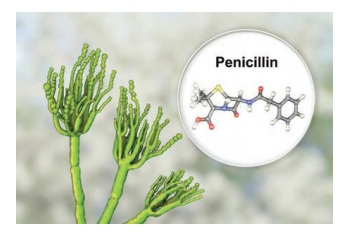Chemistry in Daily Life | Term 3 Unit 4 | 7th Science - Antibiotics | 7th Science : Term 3 Unit 4 : Chemistry in Daily Life
Chapter: 7th Science : Term 3 Unit 4 : Chemistry in Daily Life
Antibiotics
Antibiotics
Ages
ago, there was a time where even a small infected wound can cause death in human
beings. The discovery of antibiotics changed all. Now armed with antibiotics,
many deadly infectious diseases can be tackled, which once meant to cause
serious illness and death.
The
discovery of antibiotics was an accident, which happened in 1928 while a
British bacteriologist, Dr. Alexander Fleming was involved in research on
staphylococcus bacteria. This bacterium was meant to cause deadly diseases such
as pneumonia, sour throat, etc. The discovery happened while he was culturing
the bacteria on a nutrient agar media in a Petri dish. He went on a holiday
carelessly leaving the dish in his laboratory table without cleaning and
sterilization.
After
several days, when he returned back, he observed the growth of mould (kind of
common fungus, which grows on stale bread/ cheese) on a part of the Petri dish.
He also observed that there was no bacterial growth surrounding the mould,
which indicated that something in the mould had prevented the growth of
bacteria in the culture medium. On further research, Fleming identified that
the “mold
juice” was capable of killing a wide variety of harmful bacteria, such as
streptococcus, meningococcus and diphtheria bacillus.

And
that was how the world’s first antibiotic penicillin – was discovered. Fleming
named the mould penicillum notatum, from which the antibiotic penicillin was
isolated. However, Fleming was not the first using moulds and other living
micro organisms to treat infections. Thousands of years ago, the ancient
Egyptians, had used mouldy bread to treat infected wounds. Similar practices
were observed among ancient Greeks, Serbians and even among Indians. While
these were perhaps partially effective, their efficacy is nowhere near the
modern antibiotics.
Naturally, many micro organisms and plants synthesize chemicals which are toxic in nature to protect them from invading organisms. The biosynthesized chemicals isolated from the plants/micro organisms and used as medicines against infectious diseases. These substances were called as antibiotics. Ex: Chloramphenicols, tetracyclines, Penicillin derivatives, cephalosporin’s and their derivatives. Today, many infectious diseases in the world are rare due to the advancement in antibiotic research.
Antibiotics don’t work for viruses like cold and the luf.
However, the over use of antibiotics
makes it inactive or less effective. Antibiotic resistance is defined as the
ability of the microorganisms to resist the effects of an antibiotic to which
they were once sensitive. Thus the antibiotics become less effective and we are
forced to either consume a larger dose or shifting towards the use of other
virulent variants of antibiotics. Thus the research on antibiotics is of great
importance to combat the virulent and mutated microorganisms.
Related Topics